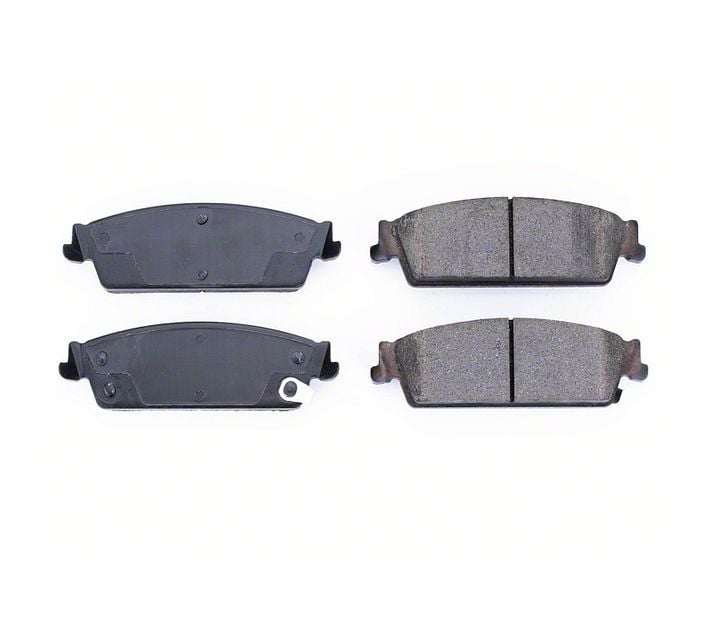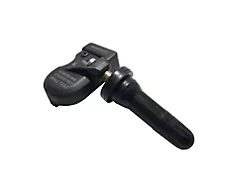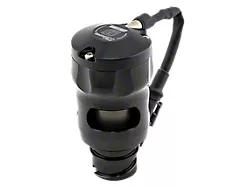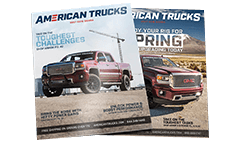
How to Install Power Stop Z16 Evolution Clean Ride Ceramic Brake Pads - Rear Pair (07-13 Sierra 1500 w/ Rear Disc Brakes) on your GMC Sierra

Shop Parts in this Guide
- PowerStop Z16 Evolution Clean Ride Ceramic Brake Pads; Rear Pair (07-13 Sierra 1500 w/ Rear Disc Brakes)
- PowerStop Z36 Extreme Truck and Tow 6-Lug Brake Rotor and Pad Kit; Front and Rear (07-13 Sierra 1500 w/ Rear Disc Brakes)
- PowerStop Z23 Evolution Sport 6-Lug Brake Rotor and Pad Kit; Rear (07-13 Sierra 1500 w/ Rear Disc Brakes)
- PowerStop Z36 Extreme Truck and Tow 6-Lug Brake Rotor and Pad Kit; Rear (07-13 Sierra 1500 w/ Rear Disc Brakes)
- PowerStop OE Replacement 6-Lug Brake Rotor and Pad Kit; Front and Rear (07-13 Sierra 1500 w/ Rear Disc Brakes)
- PowerStop OE Replacement 6-Lug Brake Rotor and Pad Kit; Rear (07-13 Sierra 1500 w/ Rear Disc Brakes)
- PowerStop Z23 Evolution Sport Carbon-Fiber Ceramic Brake Pads; Rear Pair (07-13 Sierra 1500 w/ Rear Disc Brakes)
- PowerStop Z36 Extreme Truck and Tow Carbon-Fiber Ceramic Brake Pads; Rear Pair (07-13 Sierra 1500 w/ Rear Disc Brakes)
- PowerStop Z16 Evolution Clean Ride Ceramic Brake Pads; Front Pair (07-18 Sierra 1500)
- PowerStop Z23 Evolution Sport 6-Lug Brake Rotor and Pad Kit; Front (07-18 Sierra 1500)
- PowerStop Z36 Extreme Truck and Tow 6-Lug Brake Rotor and Pad Kit; Front (07-18 Sierra 1500)
- PowerStop OE Replacement 6-Lug Brake Rotor and Pad Kit; Front (07-18 Sierra 1500)
- PowerStop Z23 Evolution Sport Carbon-Fiber Ceramic Brake Pads; Front Pair (07-18 Sierra 1500)
- PowerStop Z36 Extreme Truck and Tow Carbon-Fiber Ceramic Brake Pads; Front Pair (07-18 Sierra 1500)
- PowerStop Z16 Evolution Clean Ride Ceramic Brake Pads; Rear Pair (14-18 Sierra 1500)
- PowerStop Z23 Evolution Sport 6-Lug Brake Rotor and Pad Kit; Front and Rear (14-18 Sierra 1500)
- PowerStop Z36 Extreme Truck and Tow 6-Lug Brake Rotor and Pad Kit; Front and Rear (14-18 Sierra 1500)
- PowerStop Z23 Evolution Sport 6-Lug Brake Rotor and Pad Kit; Rear (14-18 Sierra 1500)
- PowerStop Z36 Extreme Truck and Tow 6-Lug Brake Rotor and Pad Kit; Rear (14-18 Sierra 1500)
- PowerStop OE Replacement 6-Lug Brake Rotor and Pad Kit; Front and Rear (14-18 Sierra 1500)
- PowerStop OE Replacement 6-Lug Brake Rotor and Pad Kit; Rear (14-18 Sierra 1500)
- PowerStop Z23 Evolution Sport Carbon-Fiber Ceramic Brake Pads; Rear Pair (14-18 Sierra 1500)
- PowerStop Z36 Extreme Truck and Tow Carbon-Fiber Ceramic Brake Pads; Rear Pair (14-18 Sierra 1500)
STEP 1: HAVE THE FOLLOWING PARTS AVAILABLE BEFORE YOU START THE BRAKE CHANGE:

STEP 2:
Block the rear wheels so the car won't roll once you jack it up. Put the car in park and set the parking brake firmly.
STEP 3:
Before jacking the car up off the ground, set the parking brake and loosen the lug nuts on the wheels just enough to break them free. Work them off just enough until they loosen their resistance and become easy to turn with the tire iron. Be sure to jack the vehicle on level ground, and use jack stands designed to support the weight of the vehicle. Raise the car and support with jack stands placed at the manufacturers recommended lift points. Usually the frame support area is immediately to the rear of the front wheels.
STEP 4:
Remove the lug nuts and the wheel. It is best to work on one wheel at a time, leaving the other side intact as a point of reference. As a safety precaution, roll the wheel/tire assembly under the front-center of the car, between the jack stands, and set it down beneath the engine's K-member, in the event of a faulty jack stand.
STEP 5:
Review the brake components. A disc brake assembly is composed of a caliper, two brake pads, and a rotor. The caliper works on pressurized brake fluid through a piston in the caliper. The caliper mounting bracket is bolted to the spindle, and holds the brake pads in position relative to the brake rotor. The caliper fits over the pads and is fastened to the brackets with special sliding bolts. These bolts usually have dust boots. When the brakes are applied, the caliper piston squeezes the pads against the rotor creating friction.
STEP 6:
Remove the bolts fastening the caliper to the caliper mounting bracket. Gently slide it out and away from the rotor. Hang the caliper inside the wheel well using a coat hanger, so that the hose is not stressed. Do not let the caliper dangle from the brake hose line. Inspect the inside of the caliper and remove the brake pads. Remove the two remaining bolts that hold the caliper bracket to the knuckle. Use a wire brush to clean rust from the rails where the pads contact the caliper.



STEP 7:
With the caliper out of the way, remove the rotor. Sometimes the rotor rust will make it bind and you will need to use a mallet to loosen it. Tap both the front and backside
alternating left and right, top and bottom of the rotor. The rotor thickness should be measured and compared to the minimum discard thickness that is etched on the rotor. If the thickness is less than this minimum, then the rotor should be replaced.
STEP 8:
The next step is to move the piston back inside the caliper. The piston has extended as the pad material wears. With new thicker pads, you must return the piston back inside the caliper body to give the thicker pads room for installation. First crack open the bleeder screw on the caliper to allow brake fluid to be relieved. Place a container under the caliper to collect the fluid. Get a large C-clamp, place the used brake pad over the face of the piston to protect the surface from marring, and work it back that way. As you turn the handle on the clamp, it will increase pressure on the piston, until it becomes flush with the surrounding metal. Brake fluid will be released through the bleeder. Then loosen and remove the C-clamp. Close the bleeder screw for now. If you cannot open the bleeder screw, then push the C-clamp in slowly to prevent unsafe back pressure and damage to the ABS modulator, brake valving or master cylinder. It may be necessary to drain some fluid from the master cylinder reservoir.


STEP 9:
Check and replace all hardware as needed. Improper hardware can lead to noise or poor brake pad performance. Clean the caliper rails or hardware slides where the pads make contact. Clean the hub-mating surface with a wire brush. Rust or debris on the hub can cause rotor run out and lead to wheel vibration.
STEP 10:
Resurface the rotor or replace the rotor. Most auto retailer stores provide rotor resurfacing. After machining, use a 120-grit sandpaper on the rotor in a light circular motion to give a non-directional finish. Clean the rotor with mild soap and wipe clean with a lint-free cloth. Do not use petroleum-based cleaners.
STEP 11:
Install the new rotor and remount the caliper bracket (not the piston part) to the spindle knuckle arm. Use brake grease to lubricate the edge of the brake pad backing plate
where it touches the caliper bracket sliding surfaces. Do not put grease on the friction material. The lubricant also goes between the brake pad backing plate and the piston
or caliper back. Don't over-look this. If you don't do it, you may get brake noise when you apply the brakes.
STEP 12:
With the caliper bracket bolted to the spindle, reinstall the brake pads. Slide the caliper over the pads and rotor and line up the bolt holes. Bolt the caliper to the caliper
bracket. Torque caliper and caliper bracket bolts to manufacturer specifications.
STEP 13:
Bleed the brakes to remove air from the brake line. First make sure the brake fluid is full to the top. When you open the bleeder screw, have a buddy press down slowly on the pedal as you monitor the bleeder screw. Before he releases the pedal, close the bleeder screw. This prevents sucking air back into the brake caliper. Repeat this process until you see a constant stream of fluid with no bubbles, then close the bleeder screw. It usually takes 5 or 6 pumps of the pedal to clear the air and old brake fluid out of the line. You may need to pump quite a few times more if you haven't changed your brake fluid in a long time. Check the master cylinder reservoir and replace brake fluid to the MAX line. Do not overfill the reservoir. Pump the brakes several times to seat the brake pads to the rotor and check the reservoir one more time. Top off as necessary.
STEP 14:
Replace the wheel and lugs. Drop the car to the ground to finish tightening the bolts to the manufacturer's specified bolt torque. Alternate tightening sequence by going to
the opposite side of the hub. A torque gun is not recommended.
STEP 15:
Break — in new brake pads and rotors as shown below.













